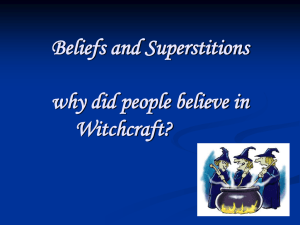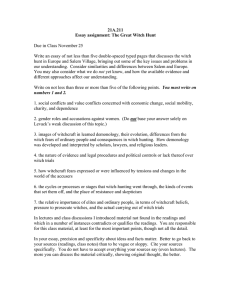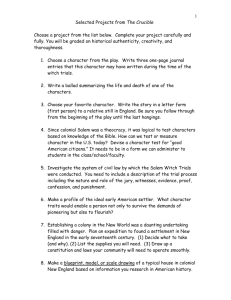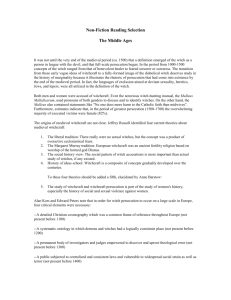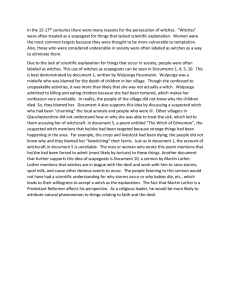Lanier.Gunther - Witches in Games
advertisement
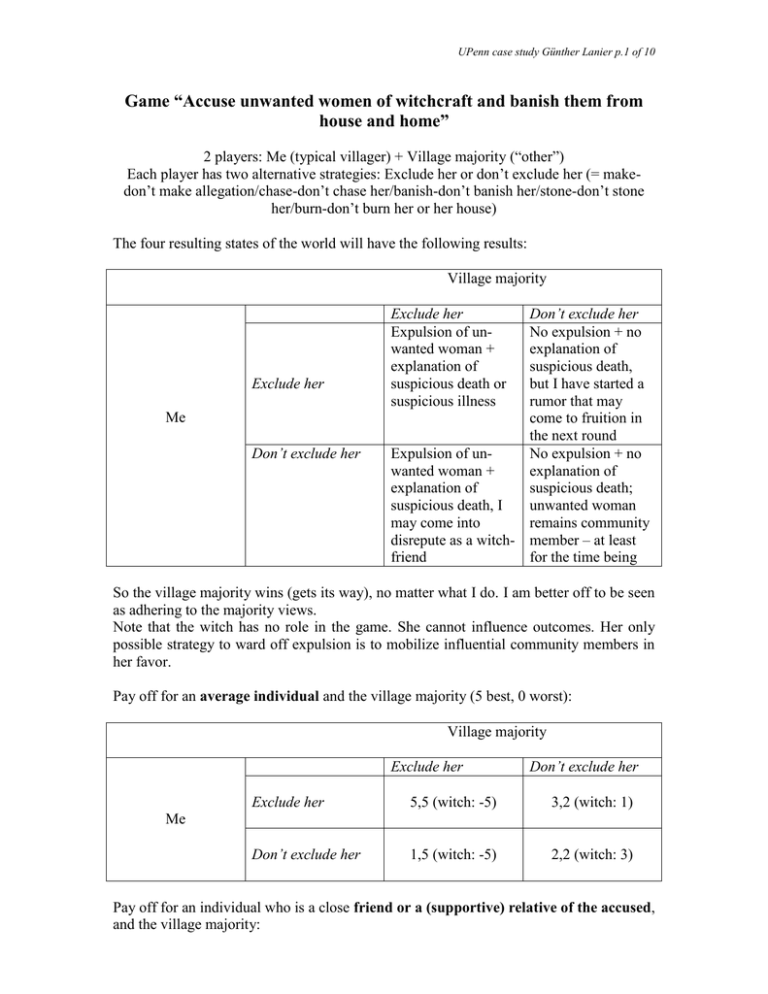
UPenn case study Günther Lanier p.1 of 10 Game “Accuse unwanted women of witchcraft and banish them from house and home” 2 players: Me (typical villager) + Village majority (“other”) Each player has two alternative strategies: Exclude her or don’t exclude her (= makedon’t make allegation/chase-don’t chase her/banish-don’t banish her/stone-don’t stone her/burn-don’t burn her or her house) The four resulting states of the world will have the following results: Village majority Exclude her Me Don’t exclude her Don’t exclude her No expulsion + no explanation of suspicious death, but I have started a rumor that may come to fruition in the next round Expulsion of unNo expulsion + no wanted woman + explanation of explanation of suspicious death; suspicious death, I unwanted woman may come into remains community disrepute as a witch- member – at least friend for the time being Exclude her Expulsion of unwanted woman + explanation of suspicious death or suspicious illness So the village majority wins (gets its way), no matter what I do. I am better off to be seen as adhering to the majority views. Note that the witch has no role in the game. She cannot influence outcomes. Her only possible strategy to ward off expulsion is to mobilize influential community members in her favor. Pay off for an average individual and the village majority (5 best, 0 worst): Village majority Exclude her Don’t exclude her Exclude her 5,5 (witch: -5) 3,2 (witch: 1) Don’t exclude her 1,5 (witch: -5) 2,2 (witch: 3) Me Pay off for an individual who is a close friend or a (supportive) relative of the accused, and the village majority: UPenn case study Günther Lanier p.2 of 10 Village majority Exclude her Don’t exclude her Exclude her 2,5 (witch: -5) 1,2 (witch: 1) Don’t exclude her 0,5 (witch: -5) 3,2 (witch: 3) Me witch friend Note that I would hardly be likely to follow the exclude strategy if others don’t want to exclude – I may on the other hand play that card if others play exclude so as not to come into the line of fire myself, especially since I cannot change outcome and am already in danger as a friend of the accused. In the case of the “average individual” there is a dominant strategy for both players: to exclude (5>1 and 3>2 for Ego, 5>2 and 5>2 for Village majority). Whether Ego is a friend of the accused or not changes nothing for the village majority whose dominant strategy remains to exclude. The friend of the accused has no dominant strategy; her or his strategy will depend on the majority. He or she is unlikely (except by some very indirect reasoning) to consider using the exclude strategy if the others don’t want to exclude. However, if the majority wants to exclude, it is in her or his interest to be seen to also want to exclude (or at least not to be seen wanting not to exclude). Clearly, the outcome of this game is determined by the village majority’s “decision” to exclude or not. There are two kinds of reasons/motivation for that: - explanation of an unnatural death/unnatural illness - getting rid of an unwanted older woman (widow, barren, strange, first wife of four and husband wants to marry a young fifth), a non-conformer, someone redundant, or irritating … Which of the two comes first depends on the case. Unnatural deaths sometimes remain without explanation (the witch is not found; the case may remain in villagers’ minds for future resolution), and attempts at getting rid of some un-liked “witch” may fail (a seed of suspicion may remain – to germinate in future cases – beware the accused in whose vicinity another unnatural death occurs). In case of a failed attempt at banishing a witch, the accuser runs the risk of revenge accusation. However this risk will usually be small since being without social support/or with very little social support is precondition for being accused (attributing supernatural powers to a strong person causes awe & respect, does not lead to his/her banishment)1. 1 The consequences of witchcraft allegations are different according to sex, age, and social standing. A Mossi proverb states that the headman’s (naaba’s) mother will never be accused of witchcraft. It is usually older women without (or with little) family backing for who witchcraft allegations may end up in their being stoned or burnt or chased from their houses and homes. Such occurrences are much rarer for men or for the “rich and mighty”. In fact every powerful man, politician or other, is thought to possess occult powers (himself or, more commonly, through intermediaries) – which generally serves to increase respect for and awe of him. UPenn case study Günther Lanier p.3 of 10 Note that this is not a dilemma and that the community is happy with the state of the world where the witch is banished (exception: the witch’s friends – who are few “by definition”). For the community it is like removing a malign tumor from its social fabric. The witch is the goat of Leviticus 16 that, burdened with all evils that have befallen the community, is expelled into the wilderness and leaves behind a community cleansed of all evil (in ancient Greece it was not a goat but a cripple or a beggar or a criminal who was cast out of the community). Note that the witch’s payoffs – in parentheses in the above tables – are identical with payoffs of the four states of the world under a human rights perspective. Note that the witch’s payoffs partly lie beyond the defined boundaries – this is to indicate the incommensurability of her or, rarely, his affliction. Empirical expectations: While witchcraft2 is an integral part of the theory of life of almost 100% of all burkinabè, the chasing/banishment of witches is first and foremost practiced by the Mossi ethnic group (the county’s dominant ethnic group making up over 40% of the entire population). While the practice seems likely to be a script that is available in most or all of Mossi territory, there are great variations in frequency of practice. James Shepley in his 2007 thesis “Women accused of witchcraft. Parameters of exclusion” found, for 500 “witches” living in three shelters (refuge centers) the following provenance (ibid. p.55): Province of exclusion Oubritenga 55 / 9% Kadiogo Boulkiemde 46 / 7% 39 / 6% Sammantanga Bazega 37 / 6% 40 / 6% Other 43 / 7% Kourw eogo 210 / 33% Passore 169 / 26% Figure 9. Province from which women in refuge center were excluded. Witchcraft has been defined as “harmful actions carried out by persons presumed to have access to supernatural powers” by Jill Schnoebelen in her “Witchcraft allegations, refugee protection and human rights: a review of the evidence”, UNHCR 2009, p.2 2 UPenn case study Günther Lanier p.4 of 10 Within these provinces, some villages are more prone than others to banish witches. “Twenty-one percent of the cases concerned villages where more than 10 cases each of social exclusion on the grounds of alleged witchcraft had been recorded (…). A further 21% of the cases were accounted for by villages that had witnessed between 3 and 9 recorded cases. Fifty-eight percent of the cases took place in villages where there had been fewer than three recorded cases” (ibid). Hypothesizing a more or less equal distribution of “real” cases of soul-eating throughout the Mossi territory, it thus seems that in the high-prevalence villages, the witch-chasescript is more readily accessible in case of need, and that in other villages, similar situations are dealt with in a different manner. Normative expectations: Within a traditional community, opposing the banishment of a witch on principle would be regarded like on principle-opposition to taking medicine in case of severe illness would be in a European context (therefore my analogy with cancer above). Overall, punishment for people considered offenders is required to be harsh (this holds for thieves, children who misbehave/disobey, excisers – if you oppose the practice). Most would probably consider the death penalty an adequate punishment for soul-eating3. Mob aggression against witches resulting in death – mostly by stoning or burning – is a none too rare occurrence (this is based on anecdotal evidence – I believe that there is no data on this). With members of a community having a vested interest in their community being kept free of evil, it is expected of everyone (that is everyone present at the time) to participate in the necessary cleansing exercise. Procedures need to be followed4, i.e. the witch must be proven to be the culprit (the most common proof is by the “siongo”, where the corpse of the “unnatural” dead, on a stretcher, carried by two or four village youths, will bump into the witch or her/his house; another possibility is consulting the diviner5 who will in some cases resort to a poison ordeal as detection method). Once the status of witch proven, and in the absence of relevant social support (the accusation is usually only aimed at the weak, but misjudgments do happen), the removal of the culprit is a logical consequence. This is a mass event, and I expect the mechanisms at work when expelling a witch to resemble those of mob lynching of thieves (I know nothing of this – Hugo Mercier has pointed me to some literature that I’ll set out to study). I, the typical villager, am expected to participate in this salutary event – like everybody else. Sanctions: Free-riding per se is not a problem in the communal chasing of the witch. Those who do not participate miss out on something: I imagine the chase to be a joyful, exhilarating event of intoxicating togetherness for the participants, who cannot but win – the opponent being alone and weak. Non-participation would thus not need punishment. However, if somebody is perceived to not participate, this may raise suspicions about her or him being an ally of the persecuted, meaning that she or he might also be a witch. This The quintessence of witchcraft lies in the eating of the victim’s soul - a (female) witch is called “mangeuse d’âme” in Burkina which translates to “soul-eater”. The victim, hence soulless, is expected to perish more or less rapidly. The witch, as a result of devouring the other’s soul, adds vital energy to her own. 4 With illness, symptoms vary with regard to their potential of witchcraft involved. Epidemics of meningitis (that happen fairly frequently in dry season, between January and March) are high-times of witchery allegations, the stiff-neck symptom being a typical symptom/consequence of a soul-eater attack. 5 There are diviners specialized in detecting witches. 3 UPenn case study Günther Lanier p.5 of 10 might – immediately or later on – lead to witchcraft allegations against the concerned, and we know what dangers this entails. I expect that some kind of exception will be made for close family and known friends (who will be few – or the banishing would not happen). I expect them to be expected to not or little participate in the witch-chase. I expect them to be expected to not oppose the chasing, since proof has been provided. And since they will want to go on living in the community … I have anecdotal evidence of half-hearted participation of a friend or a relative in a witch’s expulsion – I doubt once again, that data exist on this. Social norm: If a person (mostly a woman) has been proven guilty of practicing witchcraft (soul-eating), that person (usually a woman) is to be banished from the village or killed. With empirical and normative expectations as well as sanctions in place, this is clearly a social norm. Scripts: The chasing of witches is a script in itself. It harmonizes/fits in well with the script of “womanhood”, which includes the perception of woman as the eternal other/ stranger: in her family of origin because she will leave to go and live with her husband’s family (patrilocality), and in the home of her husband because she is from elsewhere and her real affiliation is thought (expected) to be with her family of origin. The witch banishment norm also harmonizes well with the woman submission norm (with the beating of women – largely thought justified by burkinabè women themselves (see MICS 2006) – a sub-norm) and further reinforces the high value assigned to woman servility. The norm and practice also reinforce the underlying value of conformity/not standing out in the crowd, that helps prevent dangerous individualism6. Note that there is a certain contradiction, however, between the witchcraft script and the generally almost excessive weight and worth of blood and family relations: the African witchcraft schema has close relatives as the most endangered – small children in the first place, but husband deaths are often triggers for witchcraft allegations (widows tend to belong to the unwanted class of people/women, unless there is a brother of the deceased who is interested in inheriting the widow as wife). Witchcraft allegations thus undermine family solidarity. They also provide an outlet for intra-familiar tensions that would otherwise not be admissible and even less voiceable. Reference groups: There seem to me to be two relevant (and largely overlapping) networks involved. The first is the group that prepares the ground, where witchcraft allegations are first voiced and debated, thus tested and then spread. It will likely be difficult to mark the exact boundaries of this group, the relevant relationships between participating community members will be gossiping, to some extent friendship, to a large extent traditional and ritual authority (with earth masters and diviners on top of the hierarchy). This will be the reference group as long as the allegations remain more or less underground. This underground stage can be short or it can take a long time. Out of this group will come the initiative to get proof of someone being a witch and the culprit. 6 see Peter Geschiere, Sorcellerie et politique en Afrique. La viande des autres, Paris, Karthala, 1995 (The modernity of witchcraft, Politics and the Occult in Postcolonial Africa, Charlottesville, The University Press of Virginia, 1997) as well as Alain Marie et al, L’Afrique des individus, Paris, Karthala, 1997 UPenn case study Günther Lanier p.6 of 10 The second relevant network will be those present when the actual chasing of the witch takes place. How this group is made up will sometimes be a matter of coincidence (when the chasing immediately follows the proof, for example), but it can also to some extent be engineered: the accusers can wait for witch supporters to be away (a son who works abroad, a daughter married off in another village). I need, as already stated above, to undertake further research to know how this happens. From all this it is clear that witchcraft allegations are a community practice. Addressing it on an individual level will be pretty useless – as is clearly visible in the payoff matrix for the typical villager or also the witch friend. If change there shall be, it will need to happen on a community level. Undoing the spell Project case study “Promote senior women’s rights and their access to social benefits in Burkina Faso”, a three-year project financed by the European Union, 2009-2011 Implementing agency: Help Age International Implementing partners: Promo-femmes Développement Solidarité (PFDS), La Société de la Croix Rouge du Burkina Faso (CRBF), L’Association de la Promotion de la Femme et de l’Enfant (APF) Target locality: Arbollé and Thema Bokin departments of Passoré province (about 100 km north-west of the capital Ouagadougou) All information from: HelpAge International, Rapport justificatif provisoire DCENSAPDV/2008/149-049, Ouagadougou, June 2010 With the promotion of seniors’ (especially senior women’s) rights and their access to social benefits as the overall aim, the project more specifically set out to reduce social exclusion and violation of senior women’s rights in Burkina Faso. Multi-pronged activities reaching from activities aiming for senior women’s empowerment to lobbying and advocacy on the local, provincial and national level are planned and have been implemented since the launch of the project in March 2009. In as far as legal measures or social policies are concerned, witchcraft allegations are a field that remains largely untilled. A national conference on the topic has been held more than 10 years back, where the objective of reintegrating banished women into their communities has been set, and social ministry institutions (Cour de Solidarité of sector 4 in the capital) or, more often, religious institutions (Centre Delwendé in the capital’s sector 23, Cour de Solidarité in Thema-Bokin7) take care of women chased from their homes and villages – but they provide little more than welfare in the traditional sense: shelter, some food, some counseling … Some associations (e.g. Woo Laa) or religious bodies (e.g. the catholic Peace and Justice Commission) have started reflecting on the question 7 These three institutions mentioned provide the 500 inhabitants of refuge centers at the basis of James Shepley’s above graph on witch exclusion by province. UPenn case study Günther Lanier p.7 of 10 on a level that goes beyond providing welfare for the victims, and some activities have followed (e.g. an empowerment workshop for the inhabitants of the three centers; and a march in the centre of the capital Ouagadougou on the weekend preceding International Women’s Day 2010 – a march that started with an anti-witchcraft statement of the Mossi’s most important customary authority, the Mooro naaba, whom one could call king of the Mossi). But the HelpAge/EU project is the first time that the problem is addressed in a concrete and consistent manner, even if the concrete intervention is restricted to 14 communities of 2 departments. Activities planned respectively already started/undertaken include: Recruitment of project personnel Launching of the project Baseline study Training of paralegals in (especially women’s) human rights Setting-up of paralegal clubs Paralegal tools Paralegal fora Recycling of trainers Exchange visits Literacy training Sensitization meetings Diffusion of publications on social exclusion Establishment of identity papers Counselors for women living in shelters Sensitization of the makers of witchcraft allegations Collection of data Building/repair of wells Sensitization on hygiene Elaboration of a health manual Creation of a provincial steering committee Setting up of a departmental coordination body Annual advocacy campaigns Media workshops National conference Initiatives for law reform Networking (local, national, international) Institutional and capacity strengthening of partner organizations A tentative first evaluation: The project is holistic, deals with the problem on the several levels involved, works in important parts close to the basis, is human rights-based and aims at the empowerment of the concerned. A first indication of success of the project’s interventions can be seen when looking at the following table translated from the 2009 annual report: UPenn case study Günther Lanier p.8 of 10 Department/ commune Village Bouboulou Gonsin Number of excluded women 01 01 Number of women reintegrated into their families 01 00 Yako Yako Bokin Bokin 05 04 Samba Toéssin 01 00 Arbollé Bourra 01 01 Total 05 09 06 Action prise She returned to her mother The problem was communicated to the police and APF. The woman refused to provide enough information for monitoring her case. She fled to some relatives. The four women were reintegrated with the help of their husbands, Social ministry, AFP and the catholic mission of Bokin. The husband of the 5th woman was in Côte d’Ivoire and she returned to her mother. On the initiative of one of the paralegals, the case is presently before court. She was re-established in her community thanks to the intervention of APF, of the police and Arbollé prefect. These date reflect only the cases that were reported to local authority. They in no way reflect the province’s reality. Under “normal” circumstances, re-integration of witches into the communities that banished them or even into their families of origin is close to impossible. The reported cases, even if few, show a high proportion (3 of 5) of some success, so that a more than superficial change in the reference groups must have been reached. A baseline study was undertaken. Pages 7-12 of the 2009 annual report present its findings. These refer to living conditions, awareness and violations of rights and laws and some facts about social exclusion of alleged witches. A network analysis has not been undertaken. Identification and mapping of individuals at risk of being accused, as Ryan Muldoon suggested in his 13th of July presentation (slide 51), would certainly be most helpful. This might be too sensitive an issue to be researched by outsiders, but with paralegals partly recruited amongst villagers and partly amongst the old, this could be done in the course of this year 2010. Ryan Muldoon’s second and the first part of his third suggestions (ibid., slide 51 and 528) need to be seen together: the gossip and the respect/influence in customary matters networks interact in witchcraft matters and should be researched together to track down accusations and their spreading. Since some elders are part of the paralegal team, they should be able to provide advance information. For the rest of the research, keeping in mind how sensitive an issue this is, treading will have to be careful and attentive and competent accompaniment will most probably be required. The snowball method seems a good idea, not least for cost reasons, starting in the vicinity of each of the five cases registered in the intervention area in 2009 (see the above table). It will be interesting to see how far the reference groups extend – physical closeness and neighborhood being important aspects of such networks. The snowball method could be the most cost-efficient method to take us to the edges of the reference group. I have stated above that I believe that the marking of the boundaries of these might be difficult – the reference groups might turn out to be very fluid, with The second part of Ryan Muldoon’s third suggestion is already being tried. It is, I believe, the crux of the matter. 8 UPenn case study Günther Lanier p.9 of 10 maybe a possibility of temporary membership (physical presence at the moment of the chasing of the witch). The script of witchcraft allegations are – as a potential – available to all living in the Mossi system9, but the practice seems in actual fact concentrated geographically, an indication that outreach of each community practicing witch chasing is limited. Can the concepts of core group, critical mass, and tipping point be applied? Yes for the first: the paralegals act as the core group and are the early movers and the agents of change for the wider communities. As for reaching a critical mass, this could be a group big and influential enough in each village to successfully oppose attempts at chasing witches even if the village majority wants to exclude. Simultaneous (older) women empowerment (especially through provision of information on human/women rights and through counseling) should make protecting them easier because they become less vulnerable. The 2009 reports indicates that caution is necessary – the spreading of human rights information seems to have led to more surreptitious forms of exclusion. But with this in mind, reaching of the critical mass could be a relatively fast achievement. Not so, I fear, for the tipping point. Witch-chasing seems to be a well-embedded practice that is in harmony with traditions and morals and that has not suffered from modernization – even though it is in contradiction with several parts of the penal code – but those paragraphs have hardly ever been applied to cases of witchcraft allegations. Persistent and coherent efforts thus seem required for reaching a tipping point. James Shepley, author of the above-quoted thesis, before his departure from Burkina, confided to me in June 2008 that he thought witchcraft allegations would not stop as long as there were unexplained illnesses/deaths on Mossi territory. This would imply a dire outlook: even modern intellectuals in Burkina are singularly disinterested in diagnosis. The doctor is to provide medication, not explanation, and in the case of death, it is Wende (God) who gives and takes. Human and women rights seem to be the correct gateway for this issue – because it is broad and general and can strengthen those who are most vulnerable and where they are weak10. Because game theory (see the payoff-tables at the beginning of this paper) gives us little indication for how to proceed – the community is under the given circumstances happy to reach the witch-is-excluded state of the world. And this state of the world is in no serious contradiction with fundamental values. Stoning, burning, chasing from house and home are certainly not considered trivia, but seem just retribution when confronted with evil. That does not mean that there are no values that go in the direction of non-exclusion. Stressing solidarity, pushing for this concept to include all members of the community, deal with social tensions and problems when they are still small – foster talk and com- The term is probably inappropriate, but this reference group seems too big to call it “group” or “community”. It also encompasses very different realities, from restavecs to villagers to academics – last year, a burkinabè MP and senior staff of the Ministry of Social Affairs, after the “suspicious” death of a halfbrother, seems to have accused the responsible witch … 10 Lack of Arjun Appadurai’s capacity to aspire is no doubt especially pronounced in potential targets of witchcraft allegations. 9 UPenn case study Günther Lanier p.10 of 10 munication amongst the concerned, mediate if necessary, thus confront exclusion in its nascent stage. Given the breadth of the network of beliefs, values and practices that witchcraft allegations are embedded in, a holistic approach makes much sense. Besides information and counseling on human rights, literacy training is a cornerstone of the HelpAge project and many other activities are planned, concerning for example health and hygiene. Revenue generating activities for the women in danger but also for the communities they live in could be of help. Anecdotal evidence tells of successful re-integration of one or two “witches” into the communities that had chased them – but that acceptance came to an end when the (albeit small) monthly payments to the re-integrated witch stopped11. Genuine community discussion, community decision and – most of all, although only after careful preparation – public community commitment are probably elements that are missing in the HelpAge project. Finally a word on the law. It seems important that the state and its apparatus show that they are serious about the issue. To demonstrate that such a law would be important but on its own not enough (the burkinabè would say: c’est bon, mais c’est pas arrivé – it is good, but not good enough), let me quote from the UNHCR study – stressing that the project at hand provides ample evidence that HelpAge is more than aware of the law having to advance hand in hand with a multitude of other measures and activities. The quote does not refer to Burkina. “In some cases, states play an active role in prosecuting those accused of witchcraft; conversely, other states have outlawed witchcraft accusations and try those who0 make allegations against others. In the latter case, ‘state intervention has created the impression that the authorities are keener to protect witches than their victims.’ This is a similar reaction to the approach of colonial governments, which were often perceived to be ‘a strong ally of the witch’ because accused witches were frequently released for lack of substantive proof. If individuals subsequently took matters into their own hands, they ‘were instantly convicted of their acts and harsh sentences were meted out against them by the same colonial courts.’ This drove the practice of dealing with witchcraft underground.”12 11 This was another project, I believe of the Ministry of Social Affairs. Jill Schnoebelen, Witchcraft allegations, refugee protection and human rights: a review of the evidence, UNHCR 2009, p.32 12

